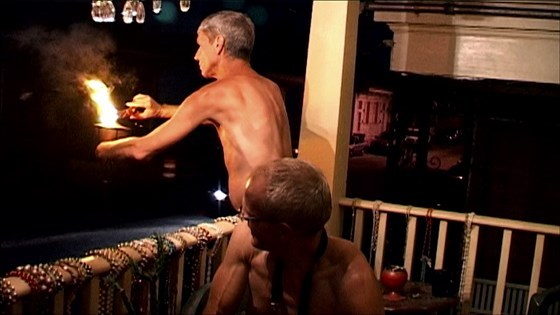
They Glow in the Dark is a documentary by Panayotis Evangelidis about two HIV-positive men loving one another, living in New Orleans, on the brink of not making it. Their names are Michael Sterling and Jim Baysinger.
The film is an interesting collage of small moments, though what is most interesting is not Michael and Jim's health, home, or poverty. What is most interesting is their relationship. The film is not so much a documentary as a portrait -- a diptych -- of two men living together with health issues, trying to make a living together selling clay dolls.
The framework of the film shows a tragic side of American life that most of America would probably prefer not to see -- at least not this intimately. The audience is likely meant to squirm in their seats as winged termites swarm around an outdoor chandelier and a cockroach rests complacently in the hand of one of the men. Watching the coarse grain of the film and the gritty vulnerability of life while flanked by truffle-butter popcorn and sauvignon blanc creates a juxtaposition that is profoundly uncomfortable, though there is also charm to be found as these two intelligent men speak in jokes and metaphor.
At one point in the film, Jim tells the viewer:
One of the things that you should know about New Orleans if you're going to spend any time here is that this is one of the sewer drains of America. A lot of people come here to either initiate or complete the process of self-destruction.
This theme of self-destruction/erosion could well be the focal point of the film, I suppose, if the viewer comes to the film expecting to be shocked. Perhaps the viewer has never seen the termites descend like a biblical plaque in the New Orleans spring, or the pervasiveness of large cockroaches in even the nicest of Southern homes. But it is in the midst of this "sewer drain" that Michael and Jim choose to persevere. In fact, the reason that they moved to New Orleans was to reunite after years of separation.
The debilitating effects of the disease are, of course, omnipresent. Its impact is visible in nearly every aspect of their lives: the rows of pill bottles, the difficulty walking, the facial muscles contracting involuntarily, the memories of deceased loved ones that punctuate their many stories. This depiction of living with HIV -- this view -- is one that American media would like to deem antiquated. It would be easy to believe, cursorily reading the headlines, that all is on the mend and survival assured. But believing becomes a bit more difficult in a city with one of the highest concentrations of HIV cases in the country.
But again, Michael and Jim's relationship is what caught my attention most, because although these two have been living together for years, they are not lovers any longer. They love one another, but they are not boyfriends. Their relationship is one of nuance, of complication; it is a relationship without sex. They eat separately, citing the lack of a dining table as the cause. They sleep separately because of Michael's spasms in the middle of the night. And yet they are partners, business partners who sell their clay art at the French Market, but also partners in the sense that they trust, rely, and manage.
During a scene in which Michael is selling his dolls on the street at night, he narrates a realization:
It occurred to me, as I sat there against the wall, with the world not noticing me, that once again, here I was, on a street selling something. This time the dolls, but before it was my body, waiting for somebody just to notice me, because I needed the money.
The desire to be seen is a recurring theme in the film. There are many discussions between Michael and Jim about the booth that they will have at the market for the coming day, the booth's value determined always by visibility. They need to be seen -- as in some ways we all need to be seen -- to survive.
Toward the end of the film, while making an illuminated sign -- "VooDoo Vials" -- to sell their art after dark, the two exchange dialogue with words that resound beyond the sign's utility. The words are stacked and coordinated in such a way that, when lit, "VooDoo" and "Vials" blink, but independently, sometimes coming together in sync, and sometimes not.
The relationship between the words seems an apt metaphor for the relationship between the two men, and this type of relationship -- gay or not -- is one that does not receive much media attention. If any facet of Michael and Jim's relationship is concrete, it is that the relationship is undefined and utterly without label. It is, in part, this relationship that renders the couple opaque to many, invisible to most. If there is one aspect of the film that I hope will be noticed by all audiences, it is this: the unusual natures of these two people and the ways in which they are (and are not) in sync.
The OUTakes programming sidebar of the New Orleans Film Festival spotlights contemporary LGBT cinema in a city that doesn't have its own major LGBT film festival. According to Clint Bowie, the program director of the New Orleans Film Society, "This sidebar calls attention to stories that too often go overlooked." And the film has caught -- and kept -- my attention. However, the film's reception in New Orleans was laced with a rather poignant revelation, as the director told the audience that aside from a Greek film festival in Los Angeles, They Glow in the Dark has not been accepted for any other American showings. I suppose whomever chooses to select or reject such films has failed to see anything of note here -- and validated one of Michael's greatest anxieties.